Milk frothers come in many shapes, sizes and styles and allow you to create a range of specialty coffee drinks in your own kitchen. Learn about the different types of milk frothers from handheld to automatic and how to use them. Skip the coffee shop and create your own customized coffee drinks just the way you like them with the best milk frother for your recipes.
Once you’ve mastered the milk frother, learn how to make the best cup of coffee at home.
What is a milk frother?
A milk frother is a kitchen tool used to transform milk into thick and silky foam and microfoam. Frothed milk is usually added to coffee and espresso to make café au lait, cappuccinos, lattes and more. Milk frothers can be powered by hand, battery or electricity and come in many shapes, sizes and styles including handheld, pitcher-style and espresso machine steam wands.
What does a milk frother do?
Milk frothers aerate milk, creating tiny microbubbles that lend a light and creamy texture to milk while increasing the overall volume. Various techniques used while frothing result in different kinds of foam from velvety smooth textures for lattes to fluffy foam for cappuccinos. Depending on the type of milk frother, it may aerate through agitation by pumping or whisking milk vigorously, or through rapidly moving hot steam.
Milk frother vs steamer: what’s the difference?
The main difference between a milk frother and a steamer is, of course, the use of steam. Milk frothers without steam use agitation to introduce air into milk. Some electric frothers feature a heating element that also warms the milk. The result is usually a light and airy foam. A milk steamer on the other hand, uses heated, high-pressure steam to both heat the milk and aerate at the same time. The foam created by a steamer tends to be finer with microbubbles that create a glossy sheen throughout the milk body.
What is the point of frothing milk?
Frothed milk adds a pleasurable taste and texture to many coffee and espresso drinks. It can balance out the bitter taste and thin texture of coffee with a light, slightly sweet creaminess. Regular milk, on the other hand, is heavier and can overwhelm coffee’s consistency and robust flavor.Frothed milk itself can be created in a variety of textures to match your tastes or drink recipe. For example, latte milk should be glossy and resemble wet paint when finished frothing. This will create a silky texture throughout the entire beverage, in contrast to something like a cappuccino that features a defined, thick layer of foam floating on top.
Types of milk frothers
The most basic type of milk frother is a manual model which resembles a french press and requires you to rapidly pump a plunger. A milk frother wand is a handheld milk frother that usually features a disc or round whisk on the end and can be electric or battery-operated. An automatic milk frother is activated at the touch of a button and often looks like a compact kettle or cylinder with a heating element and a whisk inside. Steam wands are milk frothers usually attached to espresso machines for an all-in-one device.
MANUAL | AUTOMATIC | HANDHELD WAND | STEAMER WAND | |
POWER | No power needed | Typically uses electricity | Typically battery operated | Uses electricity: attached to espresso machine |
FROTHING METHOD | Plunger | Whisk | Whisk / Spinning disk | Injects steam into coffee |
HEATER | Does not heat milk | Heating models widely available | Some models will heat milk | Always heats milk with steam |
TOP BENEFITS | Low cost, cordless, classic design | Convenient, multiple settings, hands-free | Portable, easy to store, more control | Steams and froths, good control, more delicate foam |
KitchenAid brand offers an automatic milk frother attachment for it’s semi-automatic espresso machines that offers the advantages of a steamer and the convenience of automation. The programmable dosing and a variable micro-foam adjuster allow you to adjust the milk amount and texture to match your taste and preference.
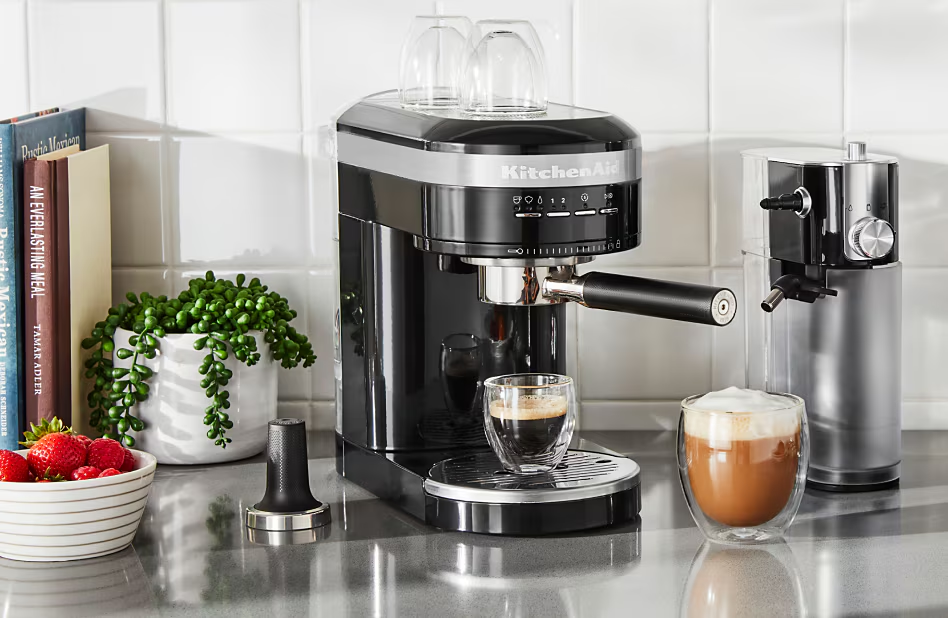
How to froth milk with an espresso machine steam wand
For most types of milk frothers, remember to only fill your container about ⅓ full. Frothing milk increases the volume significantly so make sure you leave enough room. Since frothed milk is usually added to hot beverages, you’re probably wondering: do you froth milk hot or cold? The answer is always use cold milk when frothing. When milk is heated, fats and proteins can break down and lead to less stable foam. Since any kind of frothing will add a little heat (even manual frothers use friction), it’s best to start with cold milk as you begin to aerate.
Most battery powered or electric milk frothers are easy to operate, typically starting and stopping at the touch of a button. An espresso machine steam wand is usually activated by switching to steam mode. This type of milk frother can yield silky, delicious results and is a more hands-on method of crafting your favorite espresso drink. Follow the steps below for frothing with a steam wand:
WHAT YOU’LL NEED
Semi-automatic espresso machine
Cold milk
Step 1. Switch to steam mode
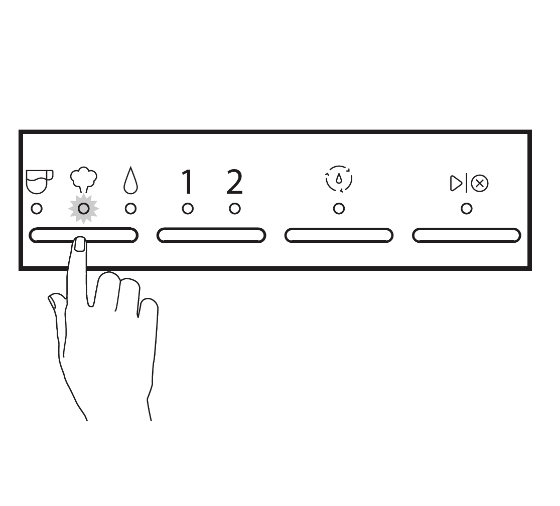
Many residential semi-automatic espresso machines will feature a mode switch for brewing espresso, steaming and sometimes for pouring hot water. Steam mode will begin heating water to the right temperature and switch the outlet source to the steam wand.
Step 2: Add milk to your pitcher
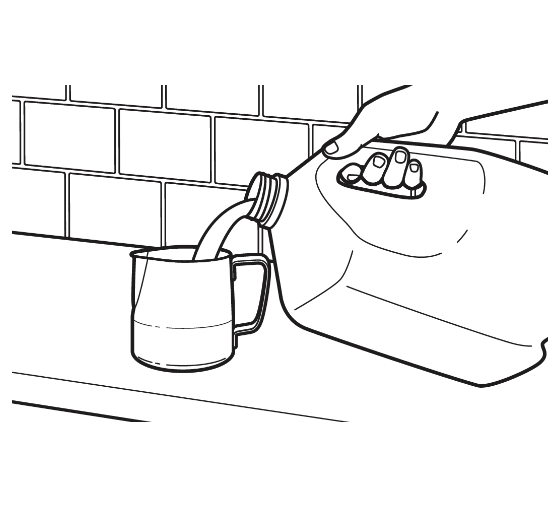
Fill a pitcher about ⅓ full with cold milk. Make sure to use cold milk straight from the refrigerator just before you begin to froth and steam.
Step 3: Purge the wand
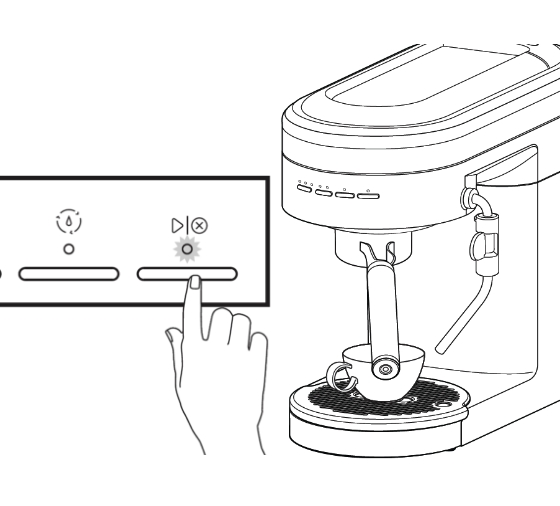
You may need to release some built-up water in the wand before it begins to steam. If so, angle the wand towards the drip tray, then activate the steamer to collect the water. Once it turns to steam, deactivate the steamer again.
Step 4: Insert the steam wand
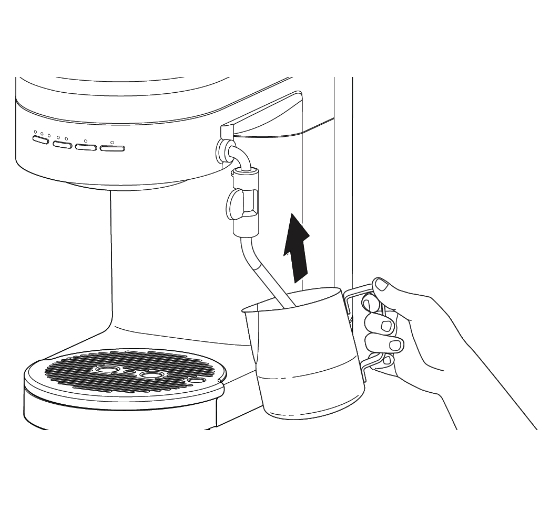
Submerge the tip of the steam wand into the milk to steam and foam. To create light and fluffy foam, angle the pitcher and keep the steam wand just below the milk surface. To heat and steam, submerge the wand further into the milk, tilting the pitcher to create a whirlpool. This helps circulate the milk for even heating and creates tiny microbubbles.
Step 5: Create desired amount
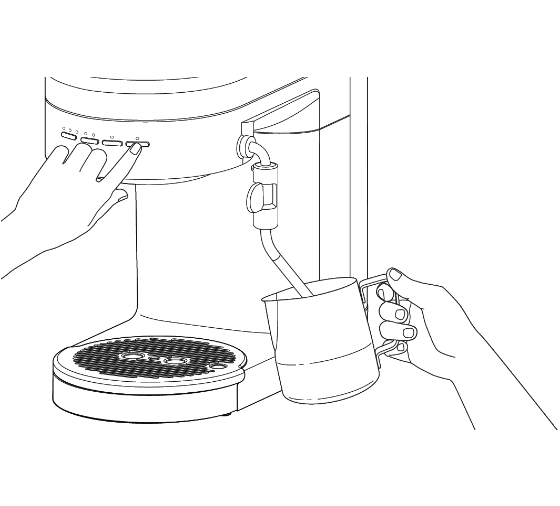
Froth until desired level of foam and temperature is reached, then remove the pitcher from the steam wand and deactivate it.
Learn how to clean a milk frother between uses.
Step 6: Tap or knock the pitcher
Tap the pitcher on the counter a few times to knock out larger bubbles. If desired, swirl the pitcher to mix in the foam and microbubbles for a uniform result. If you are making cappuccino or another beverage that calls for dry foam, skip swirling to keep the foam on top from mixing in.
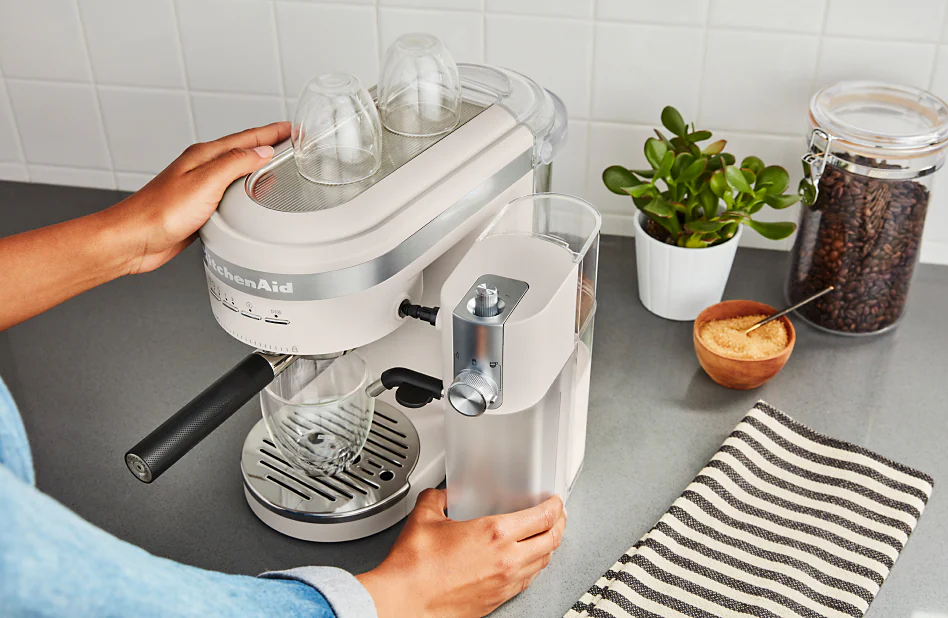
If you’re looking for a simpler way to heat and froth milk, the KitchenAid® Automatic Milk Frother Attachment is a great option. It’s compatible with the KitchenAid® Semi-Automatic Espresso Machines and effortlessly heats and froths milk for delicious lattes, cappuccinos and more, all with just a few simple controls. It can be purchased separately, or bundled with the espresso machine.
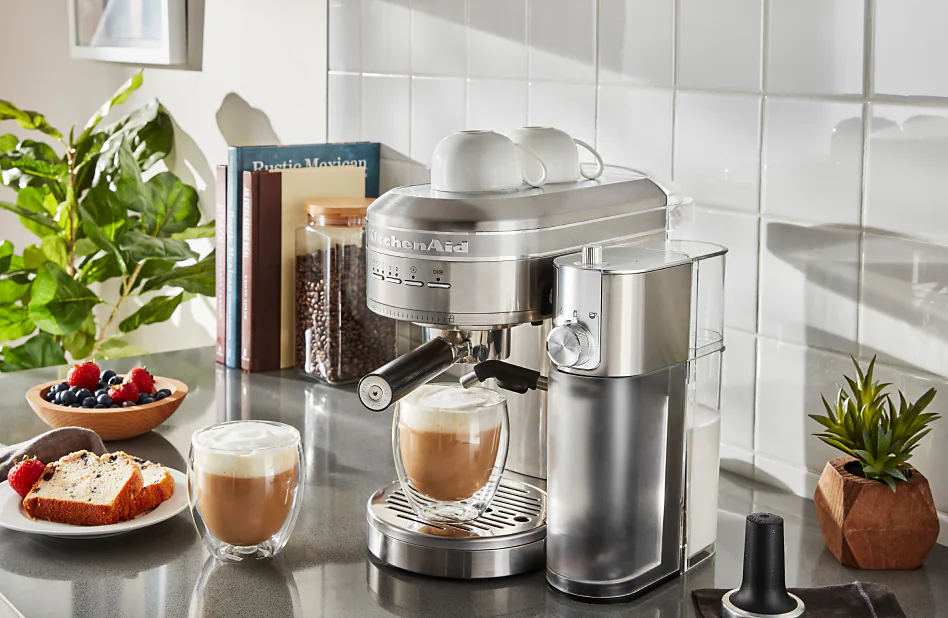
How to froth milk with the KitchenAid® Automatic milk frother attachment
The Automatic Milk Frother Attachment allows you to create a range of results with just a few steps. Create smooth, glossy milk with microfoam for lattes, flat whites and cortados, or thick foam for cappuccinos and macchiatos. The Attachment simply connects to KitchenAid® Semi-Automatic Espresso Machines, replacing the steam wand. Once attached, follow these steps for consistently delicious results:
WHAT YOU’LL NEED
KitchenAid® Automatic Milk Frother Attachment
Cold milk
Step 1. Choose your function
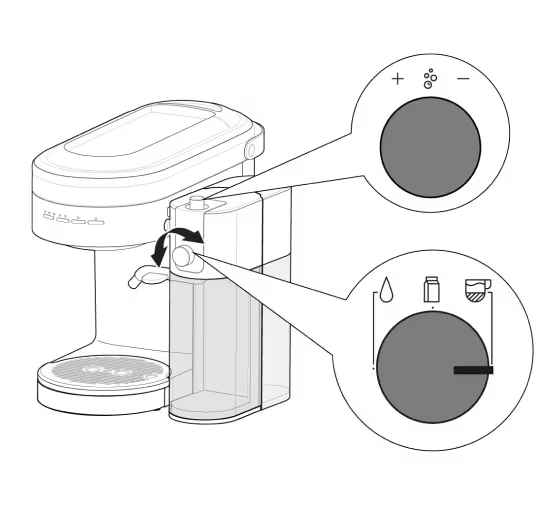
Turn the Function knob on the front of the attachment to the Froth Milk setting or the Hot Milk setting. If Frothing, rotate the Froth Level Adjustment knob on the top to increase or decrease the amount of foam. The froth level can be adjusted throughout the automatic frothing cycle by rotating the froth level adjustment knob.
Step 2: Select steam setting
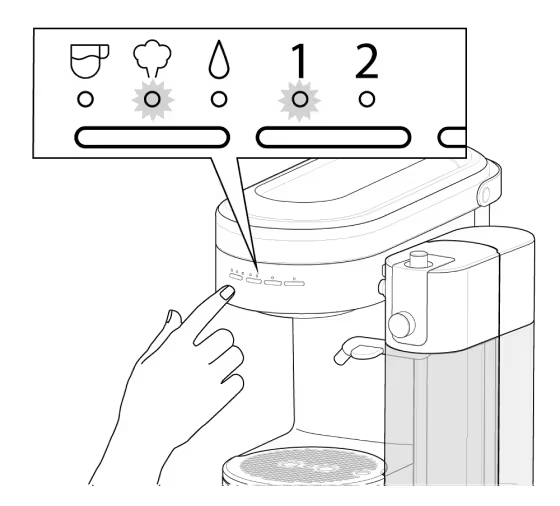
Turn on the Espresso Machine and toggle the Mode button to select Steam. Toggle the Dose button to 1 or 2 (1 for less milk and 2 for more milk).
Step 3: Start the cycle
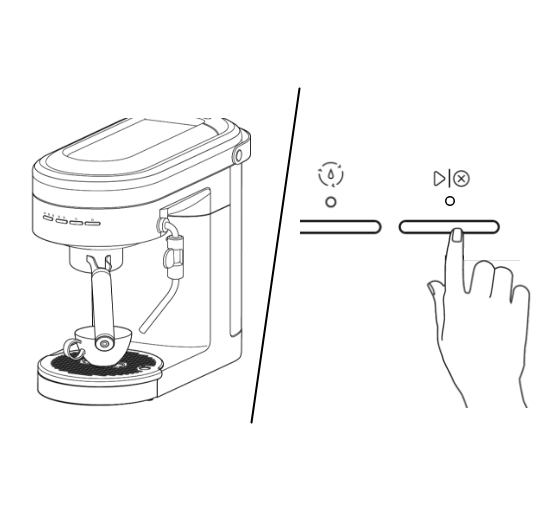
Place your cup below the portafilter and milk dispenser. Press the start button on the Espresso Machine to start the cycle.
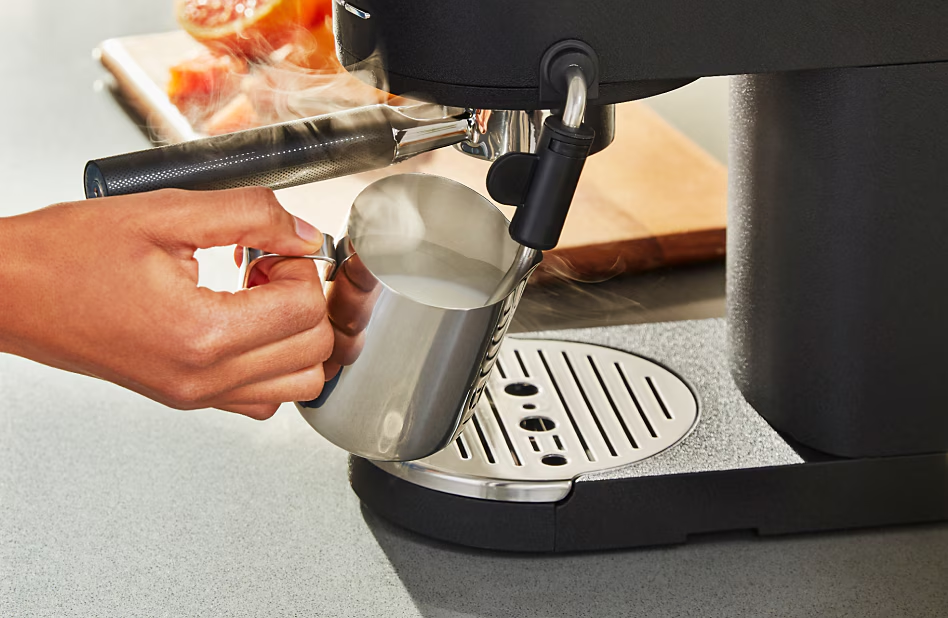
What milk froths best?
A smooth and creamy espresso drink is possible with many kinds of milk, including non-dairy plant and nut varieties. Each type of milk will bring unique flavors and textures to your latte as you steam, froth and mix in your favorite ingredients. However, the results will vary depending on a number of factors like fat and protein content, viscosity and technique used.
Frothed Whole Milk: This is the ideal milk for frothing with a great balance of fat, sugar and protein. Whole milk will create a thick, velvety result but will take a little longer to achieve more voluminous foam for drinks like cafe macchiatos and cappuccinos.
Frothed Skim Milk: With less fat, this type of milk will froth quickly and create larger bubbles. You can knock out too-large bubbles by tapping the pitcher after frothing.
Frothed Cream Milk: While you can froth and steam cream or flavored coffee creamers, the high fat content may prevent the lighter foam needed for some espresso beverages. Cream will work better for drinks like cafe au laits and lattes.
Frothed Almond Milk: Almond milk has a higher fat content than some other non-dairy alternatives. This makes it a good choice for steaming and frothing and will yield similar results to using 2% milk (which is somewhere between whole and skim). This is also a good non-dairy option if you’re making latte art because the foam tends to be stable.
Frothed Soy Milk: Soy milk will also yield a nice light and airy result when frothing. Use soy milk for options that call for drier foam.
Frothed Oat Milk: Oat milk will froth up creamy and slightly sweet but should be used and consumed quickly as the bubbles formed may be less stable.
Do you froth milk hot or cold?
Always froth milk cold. When milk is heated, fats and proteins can break down and lead to less stable foam. Since any kind of frothing will add a little heat (even manual frothers use friction), it’s best to start with cold milk as you begin to aerate.
How long do you froth milk?
If you’re using a manual frother, expect to be plunging rapidly for about 30 seconds. A handheld wand will also take about thirty seconds of moving the wand up and down throughout the cup. A steam wand, on the other hand, should take only around 5 to 10 seconds. Stop frothing when milk has about doubled in size. Automatic frothers will stop automatically when milk has reached the selected level of froth.
KitchenAid Chef
— Sharing our passion for making
At KitchenAid, we unite people who love cooking and baking, brewing and creating. For over 100 years, KitchenAid has worked on behalf of every Maker out there. Our iconic tools are made with you in mind — opening the door to new possibilities and helping you to get most out of making.
